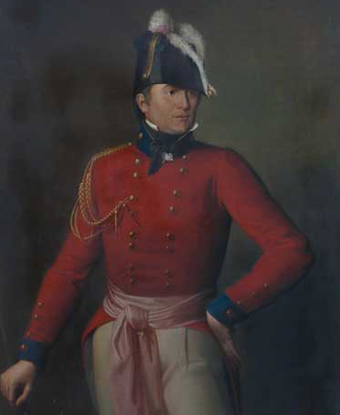Last updated: December 7, 2022
Person
Robert Ross

Smithsonian Institution
Robert Ross was born in Rostrevor, County Cork, Ireland in 1766. He was educated at Trinity College in Dublin, but as the son of a British officer who fought in the Seven Years’ War, there was little doubt that he would follow in similar footsteps. Robert Ross enlisted as an officer in the 25th Regiment of Foot in 1789 at 23 years of age.
Ross worked his way up the ranks through distinguished service in the Napoleonic Wars, participating in the capture of Alexandria, the Battle of Maida, and was wounded in the Battle of Orthes during the Peninsular War in Spain. By 1814, after 25 years of service, he was elevated to Major General. With the British government looking for experienced officers to lead the troops in the east coast of the United States, he was sent across the Atlantic to serve.
Upon arrival in Bermuda in the summer of 1814, Ross was given command of 4,500 troops, and transported to the Chesapeake by Vice Admiral Sir Alexander Cochrane’s fleet to rendezvous with Rear Admiral George Cockburn. They navigated up the Patuxent River, moving by land, but keeping the Royal Army close by. The army sieged small towns on the march, but Ross’ eyes were firmly set on Washington. The primary mission was to seek retaliation on the capital city for the American invasion and burning of York, Canada the year prior.
Ross personally led the victorious sieges, including at the Battle of Bladensburg on August 24, 1814. When the invading army arrived in Washington, Ross took command easily, ordering the burning of all public buildings, including the White House, Capitol, and Library of Congress. He was insistent on preserving private property and punished troops that disobeyed that order. Although appreciated by the Americans, it was a controversial order among the British.
Upon retreating following the successful attack on Washington, Ross (along with Cochrane and Cockburn) ordered the attack on Baltimore commencing on September 12, 1814. Ross was a popular leader, and always rode out first to lead his men into battle. During the Battle of Baltimore, this bravery and leadership proved fatal. He was killed by American snipers early in the battle.
Ross’ body was eventually sent to Canada for burying in British protectorate soil. He is memorialized by an obelisk near his birthplace in Ireland, a monument in St. Paul’s Cathedral in London, and even in the American Capitol – a building he personally ordered destroyed – a portrait honoring him hangs.
